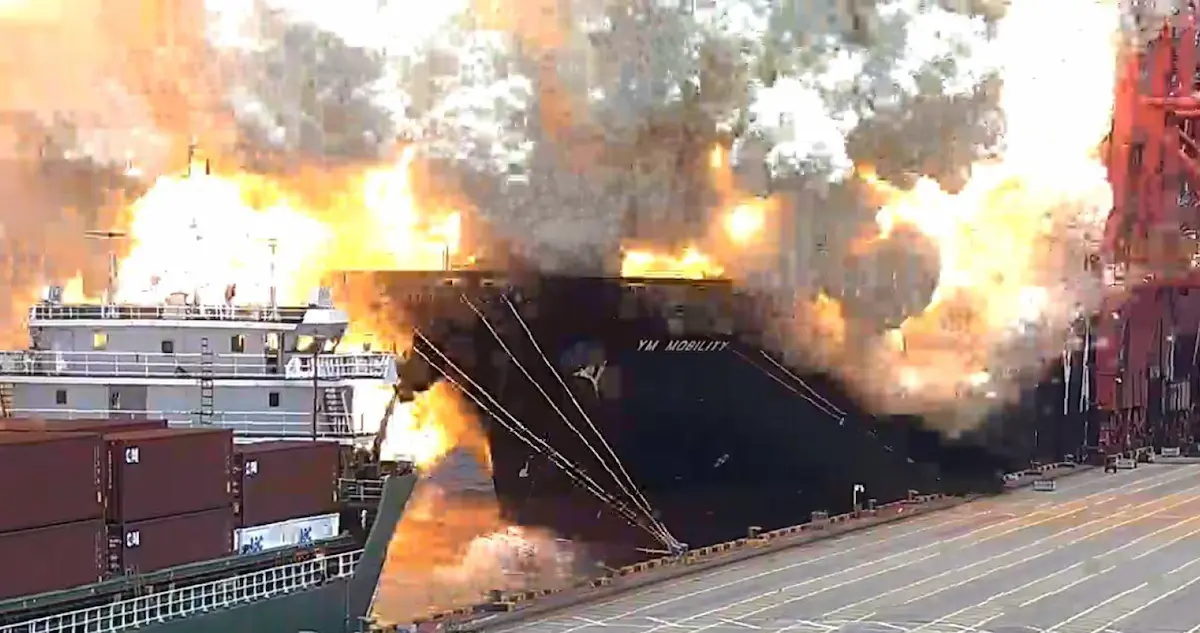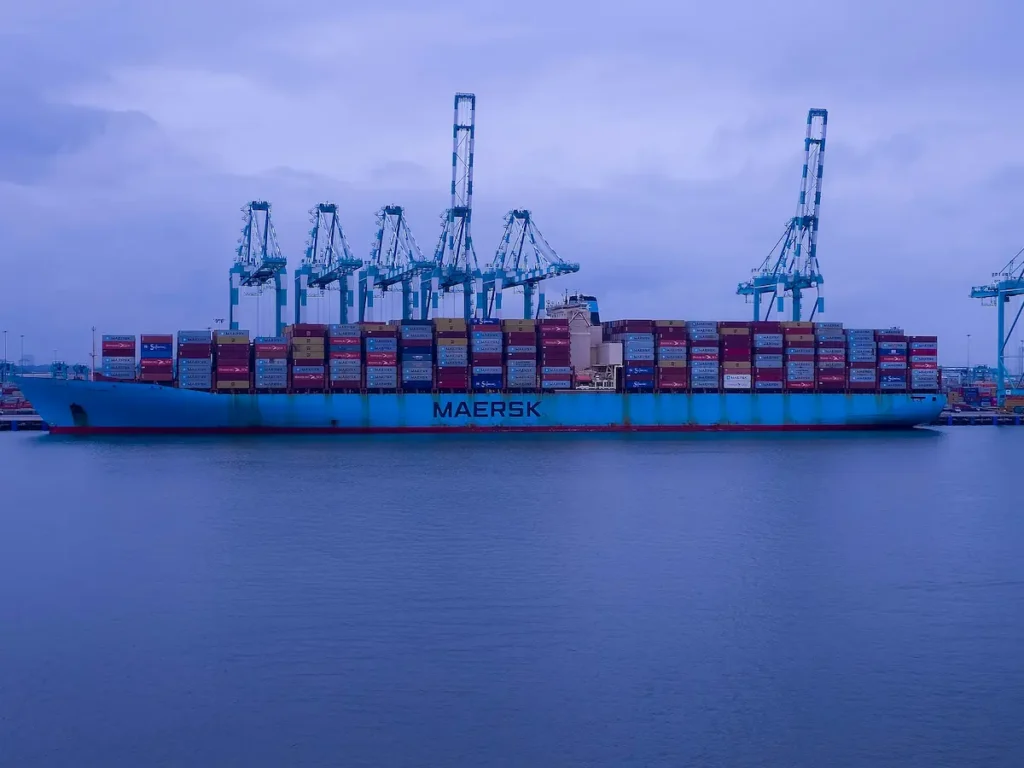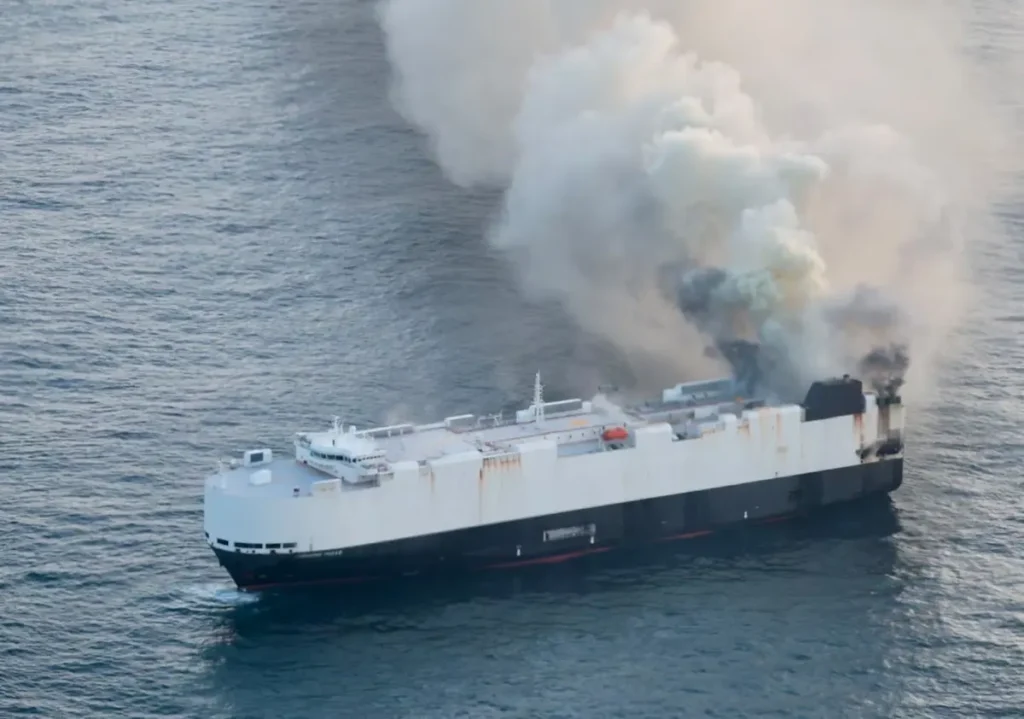On a hot day in August 2024, a routine operation at Ningbo-Zhoushan Port quickly turned into a major maritime emergency when an explosion on board the container ship YM Mobility, caused a large fire, heavy damage to the vessel, and losses of around USD 12.3 million..
A report released by the Maritime Safety Administration of the People’s Republic of China (MSA) has identified the reason for the incident and provided full details..
The incident involved a container loaded with a Class 5.2 dangerous good — Tert-Butyl Peroxy Benzoate (TBPB) on board the Liberian flagged YM Mobility (referred to as only “M” in the report..
The incident has raised serious concerns about how the industry manages high-risk cargo in extreme weather, and how assumptions around equipment usage — like reefer containers — can quickly become dangerous oversights..
The chain reaction that led to the YM Mobility disaster
The investigation by the MSA found that the explosion was triggered by a thermal runaway reaction of TBPB — a substance known for its heat sensitivity and self-decomposition properties..
Here’s what unfolded:
- The TBPB was packed properly in certified containers and stored inside a refrigerated (reefer) container..
- However, the container was not plugged in during the sea voyage. This was a deliberate choice agreed upon by both shipper and carrier due to lack of reefer slots..
- The unplugged reefer created a sealed, insulated environment, effectively becoming a heat trap..
- During transit and storage, the container was exposed to external temperatures up to 40°C..
- The cargo’s heat generation exceeded its heat dissipation capacity, leading to self-accelerated decomposition, massive heat buildup, white smoke emission, and ultimately — an explosion.
To make matters worse, the cargo had been stored outdoors in high temperatures for over 15 days before sailing, compounding the risk..
A case of “It won’t happen to us” thinking
This incident is not just about chemical properties.. It’s about decision-making — and where risk awareness fell short:
- The carrier accepted a high-risk cargo into an unplugged reefer, probably assuming it was “just like a dry box”..
- The shipper, despite knowing the cargo’s sensitivity, did not insist on proper temperature controls or real-time monitoring..
- Neither party factored in the summer heat, nor the prolonged exposure on land before departure..
- There was no contingency plan in case the temperature inside the box began to climb..
The chain of decisions, each seemingly reasonable in isolation, created the perfect storm..
Lessons for the shipping and freight industry from YM Mobility
This incident is a wake-up call for how we treat temperature-sensitive dangerous goods — especially in the face of rising global temperatures and peak summer operations..
Here are key takeaways:
- Not all reefers are created equal – Using a reefer container as a dry box might make logistical sense, but it can be a fatal decision when the cargo is chemically active or thermally unstable.. Insulation = heat trap when unplugged..
- Temperature control should be based on actual risk, not just IMDG mandates – While TBPB doesn’t require mandatory temperature control per the IMDG Code, its known characteristics clearly warrant risk-based operational controls, especially in hot weather..
- Shippers and carriers share joint responsibility – Both parties must perform a joint hazard assessment, considering:
- Cargo properties
- Transit duration
- Seasonal climate
- Container type and condition
- Operational feasibility of real-time temperature monitoring
- Data should guide booking decisions – Carriers must invest in smarter booking systems that flag risks based on cargo metadata, not just checkbox compliance.. AI-assisted vetting of DG cargo could help avoid human oversight..
- Pre-shipment dwell time matters – Extended pre-carriage exposure — especially in open yards during heatwaves — should be tracked and incorporated into the cargo risk model..
Lessons NOT LEARNED by the industry
While there are important lessons to draw from the YM Mobility’s Ningbo incident, it is equally important to acknowledge the lessons the industry seems to ignore..
Explosions linked to heat-sensitive cargoes are not new, nor are they isolated cases.. Consider the MSC Flaminia disaster of July 2012 — a chilling reminder of what happens when cargo volatility meets oversight gaps..
That incident, involving the explosion of DiVinylBenzene (DVB) on board the MSC-operated vessel, tragically claimed the lives of three crew members mid-Atlantic..
The investigation traced the root cause back to the thermal instability of the DVB, which had degraded during transit due to improper handling and lack of temperature control.
In that case, a liability of 55% was assigned to the shipper Deltech and Stolt the tank container operator assigned the balance of 45%..
Who was held responsible for the YM Mobility explosion..??
The final investigation report is unequivocal in assigning accountability..
Both the shipper and the carrier were held responsible for the incident..
The shipper proposed a dangerous workaround — using a thermally insulated container without plugging it in — while failing to fully assess the explosive potential of TBPB in high-heat conditions..
The carrier, despite being the final gatekeeper, accepted the cargo under these terms without proper scrutiny or temperature monitoring, even during a summer heatwave..
This joint failure to apply due diligence — despite regulatory compliance — is what ultimately led to the fire and explosion on the YM Mobility..
Conclusion: Compliance ≠ Safety
The YM Mobility Ningbo incident, though less deadly, follows a familiar pattern to that of the MSC Flaminia, thermal risk underestimated, transport decisions made in isolation, and compliance treated as a checkbox rather than a process of continuous hazard evaluation..
The YM Mobility incident proved that regulatory compliance does not guarantee safety.. Every cargo has a context — and in this case, ignoring that context led to an entirely avoidable disaster..
As the industry moves forward, we must view temperature-sensitive dangerous goods through a lens of operational reality, not just documentary correctness..
Collaboration, awareness, and proactive risk assessment are the real keys to preventing such incidents from recurring..
Until the industry starts connecting these dots — and embedding these lessons into daily decision-making — we risk seeing history repeat itself, box by box..
Because in shipping — sometimes, all it takes is one overheated box to change everything..













